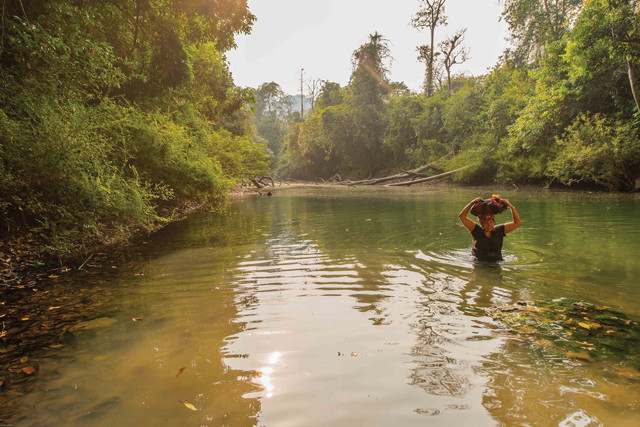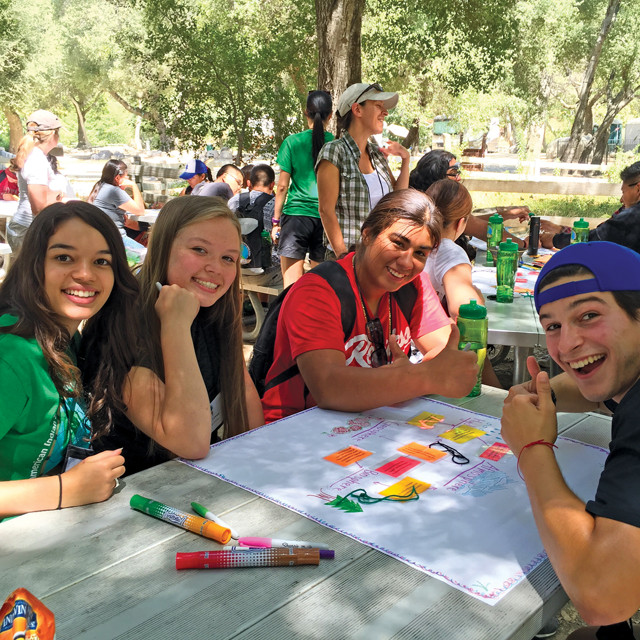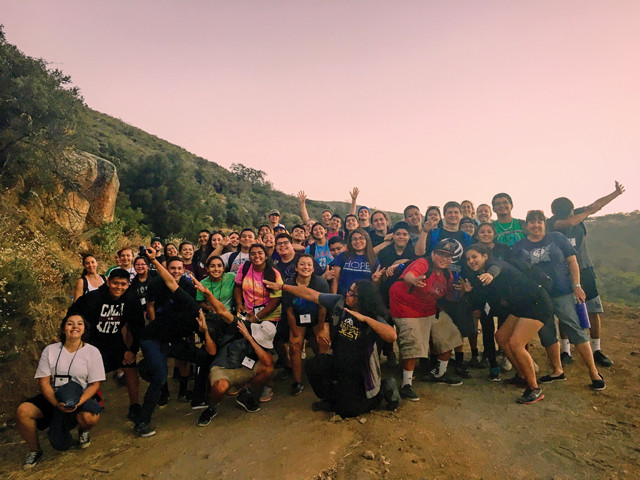
by Kate S. Zalzal Thursday, February 9, 2017

Kathleen Johnson is an associate professor in the Department of Earth System Science at the University of California, Irvine (UCI), where she studies speleothems to investigate past climates. Credit: Kathleen Johnson.
Paleoclimatologist Kathleen Johnson has some advice for anyone interested in tropical cave science: befriend experienced cave guides and beware of venomous snakes, ubiquitous bats and Frisbee-sized spiders.
Johnson, a professor since 2007 in the Department of Earth System Science at the University of California, Irvine (UCI), studies cave deposits called speleothems to understand the history of the Asian monsoon system — a critical part of the global climate system impacting billions of people. Her research has taken her to caves in China, Sri Lanka and, most recently, Laos, in an effort to better calibrate and interpret stable-isotope-based paleoclimate records and investigate patterns of past natural climate variability.
Johnson got her first taste of speleothem work as a doctoral student at the University of California, Berkeley, working with sedimentary geochemist Lynn Ingram. Neither of them had worked with speleothems before, but Johnson, intrigued by a project idea mentioned by a colleague in China, quickly began fieldwork at Wanxiang Cave in Gansu Province, China. Over the next seven years, she explored complexities in the relationships among cave geochemistry; trace element and isotope records; and local, regional and global climate.
Johnson’s current research is focused on active cave monitoring to improve understanding of the links between climate and speleothem geochemistry and on developing high-resolution paleoclimate reconstructions to capture how the Asian monsoon responded to deglaciations during the Late Pleistocene and Holocene.
Johnson, a member of the Grand Traverse Band of Ottawa and Chippewa Indians in Michigan, has also worked extensively to expose Native American youth to earth system science and to educate them on environmental and natural resource issues affecting native lands. With funding from the National Science Foundation’s (NSF) Opportunities for Enhancing Diversity in Geosciences program, Johnson developed the American Indian Summer Institute for Earth System Science at UCI, where it has been run since 2011. The institute is a free, two-week residential summer program for Native American high school students in which they conduct scientific fieldwork and develop and complete research projects related to tribal environmental issues.
Johnson recently spoke with EARTH about what makes a good cave, why it’s important to expose Native American youth to earth science, and why the next generation of scientists makes her optimistic about the future.

Johnson and colleagues from the French-led Explo Laos cave exploration project stand in a large room within Tham Houay Sai Cave in southern Laos. Johnson and her lab at UCI are working to generate carbon and oxygen isotope records from speleothems from caves located in Southeast Asia. Credit: Serge Caillault.
KSZ: What makes a cave good for paleoclimate work?__
KJ: The most important thing is that it has to have stalagmites. Stalagmites, which grow up from the cave floor as water drips off the ceiling, are preferable to other types of speleothems like stalactites — which grow down from the ceiling — because stalagmites have a more clear and simple stratigraphy. We also want to select samples from a location, usually deep within a cave rather than at the entrance, that has not been affected significantly by evaporation or by very large swings in temperature that can affect the stable isotope signal. Ideally, the cave is also hydrologically active with speleothems still forming. This allows us to do the monitoring that we would prefer to do, including measuring temperature, humidity, and carbon dioxide in the cave air, and soil sampling around the cave.

Johnson carries supplies as she wades through a river after exiting a cave in southern Laos. Southeast Asia has few long paleoclimate records due, in part, to the difficulty in getting to field sites. Credit: Serge Caillault.
KSZ: How did you start working in caves in Laos?__
____KJ: ____Some colleagues are involved in a large archaeology project in Southeast Asia called the Middle Mekong Archaeological Project. They are looking at questions about human and cultural changes along the Mekong River, and they are interested in the role that climate may have played in some of those changes. They invited me to come along for a field season in 2010. We visited about 20 caves and identified one in northern Laos that is particularly promising called Tham Doun Mai. Right now, we are trying to interpret a carbon and oxygen isotope record spanning the last 45,000 years from that cave.
KSZ: What questions do you hope to address with this work?
_KJ: There are only a handful of paleoclimate records from all of Southeast Asia. We want to understand how the monsoon system responded to orbital forcing and changes in ocean circulation. We also want to know how abrupt climate changes may have impacted human culture there.
I’m also interested in the mechanisms that control the oxygen isotope composition of precipitation — which is essentially what is recorded in the speleothem calcite. There are incredibly strong similarities between variations in oxygen isotope records from sites across Asia that are thousands of kilometers apart. Rather than reflecting local rainfall or summer monsoon intensity at a local site, it’s becoming more clear that oxygen isotope variability reflects a much larger signal related to monsoon intensity, and we don’t fully understand it yet. We’re lucky that speleothems also contain other types of proxies, like trace element ratios and carbon isotopes that do reflect more local water conditions. We’re trying to combine all those together to learn about large-scale regional climate change and also more local processes.

Johnson and her colleagues hold a speleothem just collected from a cave in Laos. Analyses of the speleothem will help characterize how the Southeast Asian Monsoon varied during the Pleistocene and Holocene. Credit: Kathleen Johnson.
KSZ: Have you encountered safety concerns in any of the caves you’ve studied?
KJ: Many of them are quite easy to get into, but we usually bring experienced cavers with us to make sure we can get through safely, and to explore new regions of the cave. We had a biologist who specializes in cave insects with us on a recent trip to Laos. He showed us some crazy stuff and tried to catch spiders the size of Frisbees. We’ve also had to be careful of vipers near cave entrances, and we encountered two Burmese pythons inside a cave once. The scariest thing that ever happened to me was when I stepped right over a cobra while hiking to a cave in Sri Lanka.
KSZ: How did you become involved with Native American youth?
KJ: Native Americans are very underrepresented in the geosciences. Yet there is a unique need for qualified geoscientists in tribal communities, given the large amounts of land managed by tribes and all the natural resource and environmental issues that face them. I didn’t grow up on a reservation, but I grew up being exposed to native culture and was encouraged to learn about it. Like many students, when I went away to college and graduate school I became a bit separated from that aspect of myself. Later, at UCI, I connected with the American Indian Resource Program, and in 2011 my proposal for the summer institute was funded.
KSZ: What do students learn and do at the institute?
KJ: Native high school students from across the country apply, and we generally select 40 students with a range of academic backgrounds. We start with a basic earth system science orientation and then head off to camp along a river on the La Jolla Indian Reservation in Southern California for about a week. While there, Julie Ferguson, another faculty member at UCI, along with the teaching assistants and I teach about the atmosphere, biosphere, hydrosphere and geosphere. We teach the students field skills and how to identify connections between various components of the earth system. We go on field trips to see the local geology and to relate it back to other earth systems.
During the second week, we come back to UCI and spend most of our time developing research projects based on tribal environmental issues — ranging from water quality issues and climate change to renewable energy and waste management. Projects on pipelines and mining come up a lot too. Many Navajo students have grandparents who have, or had, major health problems from working in the uranium mines or drinking contaminated water. We have the students look into the science of these issues, but a lot of them also look at the public health side of the issues and what can be done to improve conditions. At the end of the week, we have a symposium where the students each give a 10- to 15-minute talk.
KSZ: Do you try to incorporate a Native American perspective into teaching earth science?
KJ: We try to integrate native culture into it as much as possible — studies have shown that that’s a much more effective way to engage native youth. We try to incorporate discussions about traditional environmental knowledge into our discussions and lessons, and we bring in tribal environmental professionals whenever we can. We also incorporate other cultural aspects like bringing in local natives for storytelling or singing or dancing.

Students participating in the American Indian Summer Institute in Earth System Science (AISIESS) work together to make a poster characterizing different components of the earth system. Credit: Kathleen Johnson.
KSZ: What are the students’ favorite parts of the program?
KJ: Their favorite day is always the water cycle day, when we get in the river to take discharge measurements. We also spend a whole day on the carbon cycle. They develop hypotheses, design experiments and present their results about what factors most affect soil respiration rates. The students are generally incredibly motivated, smart and excited to be there. They are often a little surprised at how much fun it is in addition to how much they learn.
KSZ: Have students gone on to study earth science further?
KJ: Nearly all of our students who have completed high school have gone on to college, and I know of at least nine or 10 who are majoring in earth system science, geology or environmental science. By the end of the two weeks, the students have bonded and formed a supportive community. Going off to college can be really challenging for native students; they don’t usually have the sense of community that they are used to. But after the summer institute, they are part of this whole group of smart, motivated native students who take their education seriously and who want to go on to do big things. As they go into college, that becomes a major support system for them.
KSZ: What’s next for the institute?
KJ: The NSF program that originally funded this project has been phased out. The summer of 2017 will be our sixth year, but we don’t have enough funding left to do a full-scale program, so we’re planning a reunion type of event for former students who have stayed engaged in earth science. We’re also going to try for other funding, including private funds. We hope we can continue the program as is, or we may consider developing it into a broader STEM program of which earth system science will be just one component.

AISIESS students on a hike to learn about the geology and ecology of Southern California. Credit: Kathleen Johnson.
KSZ: How do you feel about earth science as a tool to solve environmental problems?
KJ: My research plays a small part in improving our understanding of the natural variability of the monsoon system. Generating these new data will hopefully improve characterizations of these systems in climate models and lead to more accurate projections of future change in those regions. There is going to be a continued need for earth system scientists, so I’m optimistic about the future of the field. Working with students, not only the native students, but also the students at UCI, makes me incredibly optimistic because the next generation is certainly up for the challenge and they have high hopes to effect change.
© 2008-2021. All rights reserved. Any copying, redistribution or retransmission of any of the contents of this service without the expressed written permission of the American Geosciences Institute is expressly prohibited. Click here for all copyright requests.